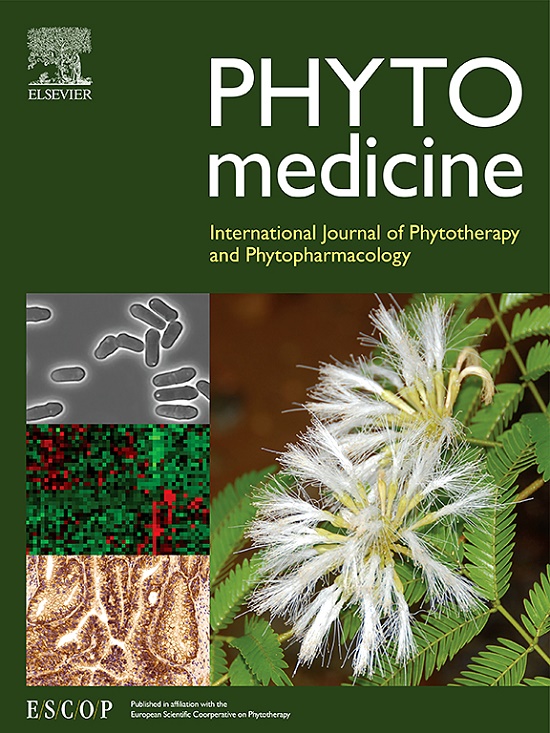Mulberry leaf benefits the intestinal epithelial barrier via direct anti-oxidation and indirect modulation of microbiota in pigs
IF 6.7
1区 医学
Q1 CHEMISTRY, MEDICINAL
引用次数: 0
Abstract
Background
Diarrhea and intestinal dysfunction commonly occur in young mammals, causing malnutrition and growth retardation in both human and livestock. As the traditional Chinese herb, mulberry leaf contains various bioactive compounds and showed several health benefits, such as regulating glucose and lipid metabolism, and modulating gut microbiota. Mulberry leaf exhibits the potential to modulate redox homeostasis and improve gut health, but the function and underlying mechanisms remains elucidative.
Purpose
To investigate the benefit of mulberry leaf on intestinal barrier in weanling pigs, illustrate the possible involvement of Keap1-Nrf2 mediated anti-oxidation and gut microbiota.
Methods
Chemical compositions of mulberry leaf powder (MLP) and mulberry leaf extract (MLE) were determined. The effects of MLP on growth performance, intestinal barrier integrity, anti-oxidative capacity, immune function and gut microbiota were evaluated in weaned pigs. The regulation of redox homeostasis by MLE and the involvement of Keap1-Nrf2 signaling were further determined in H2O2 induced oxidative stress (OS) model in IPEC-J2 cells via determining reactive oxygen species (ROS) production by flow cytometry and related protein abundance by western blot analysis.
Results
In weanling pigs, MLP reduced diarrhea incidence, and increased villus height, intestinal integrity and expression of tight junctions in intestinal mucosa. The improvement of intestinal barrier by MLP was associated with the enhancement in anti-oxidative capacity and the changes in gut microbiota and related short chain fatty acids production. Our study further revealed the direct regulation of MLE on tight junction expressions and ROS production to alleviate H2O2 induced OS in IPEC-J2 cells via the activating Keap1-Nrf2 signaling pathway.
Conclusions
Mulberry leaf in diet improved epithelial barrier via the direct anti-oxidation through the activation of Keap1-Nrf2 signaling pathway and the indirect modulation of gut microbiota in weaned pigs.
桑叶通过直接抗氧化和间接调节微生物群有益于猪的肠上皮屏障。
背景:幼年哺乳动物常出现腹泻和肠道功能紊乱,导致人类和家畜营养不良和生长迟缓。作为传统的中草药,桑叶含有多种生物活性化合物,具有多种保健功效,如调节葡萄糖和脂质代谢、调节肠道微生物群等。目的:研究桑叶对断奶猪肠道屏障的益处,说明 Keap1-Nrf2 介导的抗氧化和肠道微生物群可能参与其中:方法:测定桑叶粉(MLP)和桑叶提取物(MLE)的化学成分。评估了桑叶粉对断奶猪的生长性能、肠道屏障完整性、抗氧化能力、免疫功能和肠道微生物群的影响。在 H2O2 诱导的氧化应激(OS)模型中,通过流式细胞仪测定活性氧(ROS)的产生,并通过 Western 印迹分析测定相关蛋白质的丰度,进一步确定了 MLP 对氧化还原平衡的调节作用以及 Keap1-Nrf2 信号的参与:结果:MLP能降低断奶猪的腹泻率,增加绒毛高度、肠道完整性和肠粘膜紧密连接的表达。MLP 对肠道屏障的改善与抗氧化能力的增强、肠道微生物群的变化以及相关短链脂肪酸的产生有关。我们的研究进一步揭示了 MLE 通过激活 Keap1-Nrf2 信号通路直接调节紧密连接表达和 ROS 生成,从而减轻 H2O2 诱导的 IPEC-J2 细胞 OS:结论:日粮中添加桑叶可通过激活 Keap1-Nrf2 信号通路直接抗氧化和间接调节断奶猪肠道微生物群来改善上皮屏障。
本文章由计算机程序翻译,如有差异,请以英文原文为准。
求助全文
约1分钟内获得全文
求助全文
来源期刊

Phytomedicine
医学-药学
CiteScore
10.30
自引率
5.10%
发文量
670
审稿时长
91 days
期刊介绍:
Phytomedicine is a therapy-oriented journal that publishes innovative studies on the efficacy, safety, quality, and mechanisms of action of specified plant extracts, phytopharmaceuticals, and their isolated constituents. This includes clinical, pharmacological, pharmacokinetic, and toxicological studies of herbal medicinal products, preparations, and purified compounds with defined and consistent quality, ensuring reproducible pharmacological activity. Founded in 1994, Phytomedicine aims to focus and stimulate research in this field and establish internationally accepted scientific standards for pharmacological studies, proof of clinical efficacy, and safety of phytomedicines.
 求助内容:
求助内容: 应助结果提醒方式:
应助结果提醒方式:


